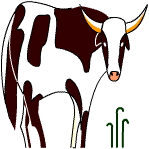Yaks
Created | Updated Jan 9, 2012

The yak's latin name is Bos grunniens, from Bos meaning Ox, and Grunnio I grunt, hence grunniens, grunting - yaks are physically unable to low or moo like other cattle.
Description
The yak is a large, hairy, cow-like mammal native to Tibet. Its dark black-brown coat is dense, woolly, and extremely shaggy, though the colour can vary in domestic yaks. Golden wild yaks are also known, though they are extremely rare. The longer hairs drag almost to the ground from the lower shoulders, sides, and flanks. Their short legs have broad hooves and large dew claws which make them well adapted to mountainous terrain. The tail is remarkably bushy and pompom-like, and was a prized trophy and used as a flyswat.
The shoulders are high and humped, supporting a broad, drooping head. Wide horns, which grow out from the sides of the head and curve upwards, are found in both sexes, though those of the females are considerably shorter. These horns can grow up to 50cm (20 inches) long in females, and 95cm (38 inches) in males.
Breeding
The yak breeding season occurs from September to October.
Domestic uses
The local Tibetan people utilise yaks in much the same way that cows are used in the western world. This includes roles such as:
- Beasts of burden, for carrying wood, belongings, etc.
- Farm equipment, for pulling ploughs
- A source of nourishing milk, which is pink
- A source of natural fibres for making clothing and tents
- ...but surprisingly, not for food. If you go to Tibet, you will not find a yak burger anywhere.
The yak is the key to survival on the Tibetan plateau. A visit to a nomad's tent illustrates this point. The tent itself, called a yurt, is made from yak hair. The interior of the tent is warmed by a fire of dried yak dung, and is illuminated by butter candles made from yak milk. All the blankets and most of the clothes are also made from yak hair. The principle constituent of the Tibetan nomad diet includes tsampa (roasted barley flour) and yak butter and dried yak's cheese.

